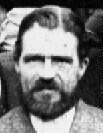

FREDERICK HAMMERSLEY
Frederick Hammersley is generally regarded to be the leader of the Transformationalists. Malcolm Bingham was more traditionally talented, John Williams produced at least one enduring masterpiece and Matthew Darlington is credited with instigating those aspects of Transformationalism which reverberate through the years and still have impact today, but Frederick Hammersley was their leader.
Frederick Hammersley came from Stoke, and I use the name as a native uses it. Stoke-upon-Trent is one of the six towns that make up the City of Stoke-on-Trent, otherwise known as the Potteries. Ask anyone inside the area where he was born and he will name his home town, ask him outside, on the beach at Rhyl or on the ski slopes of Klosters and he will say, "Stoke". So Frederick Hammersley was born and lived and presumably died in Stoke. Of his background, his parents, his father`s occupation, his own, nothing is known. There are some scraps of correspondence, all undated and none bearing his address (although a postcard to John Williams congratulating him on the publication of "Mirrorrorrim" does give us Williams` address), there is his music, his poem and his own novel, and that`s about it. The origin of his ideas, the genesis for the key concept of Transformationalism, that the world can be changed through art, is lost in the smoke-shrouded history of Stoke. One could speculate but one won`t.
The Music:
"Symphony of a Thousand: For 1,000 instrumentalists. Any instruments may be used. Anything may be played."
"String Quartet Number One: Take four pieces of string and put them on a stage."
"Symphony in D, `The Choral`: For any number of musicians. They must all sing `D` as in `dee` or `deedeedee` or `deedee` until"
(These are the original notes for Hammersley`s music, including the incomplete "Symphony in D". In Peter Stone`s article, he amends the Symphony of a Thousand to read "The musicians can play anything they like for as long as it takes to destroy the Houses of Parliament, Buckingham Palace and the National Gallery." What the source for this change is, Stone does not say. I presume he decided it would be transformationalistic to alter Hammersley`s original work to make it more political. Similarly he adds the following to the String Quartet: "Wait thirty minutes then walk onto the stage and shout: `Well, what do you expect them to do?`" Here, Stone seems to be missing the point entirely. Finally he twists the unfinished "Symphony in D" into some kind of requiem for Malcolm Bingham. This is doubly unfortunate, for it perpetuates the myth that Bingham died in the Burslem riot as well as destroying Hammersley`s early attempt at minimalism. Stone`s misguided attempt to bring Hammersley`s music to the attention of a wider audience must be considered a total failure. Although he is not mentioned in the programme or on the poster, it can be assumed that he was behind the concert at Burslem Leisure Centre on June 8th 1981 when his version of Hammersley`s Symphony in D was performed by Amphibrach Enallage and the Catalectic Paragoge as part of a series of concerts promoted by the Stoke Musicians` Collective and the Artists Action Group.)
The Poem:
hat
I
think
I
shall
put my
hat
on
today
The Novel:
HAT
I think I`ll put my hat on, today.

Back